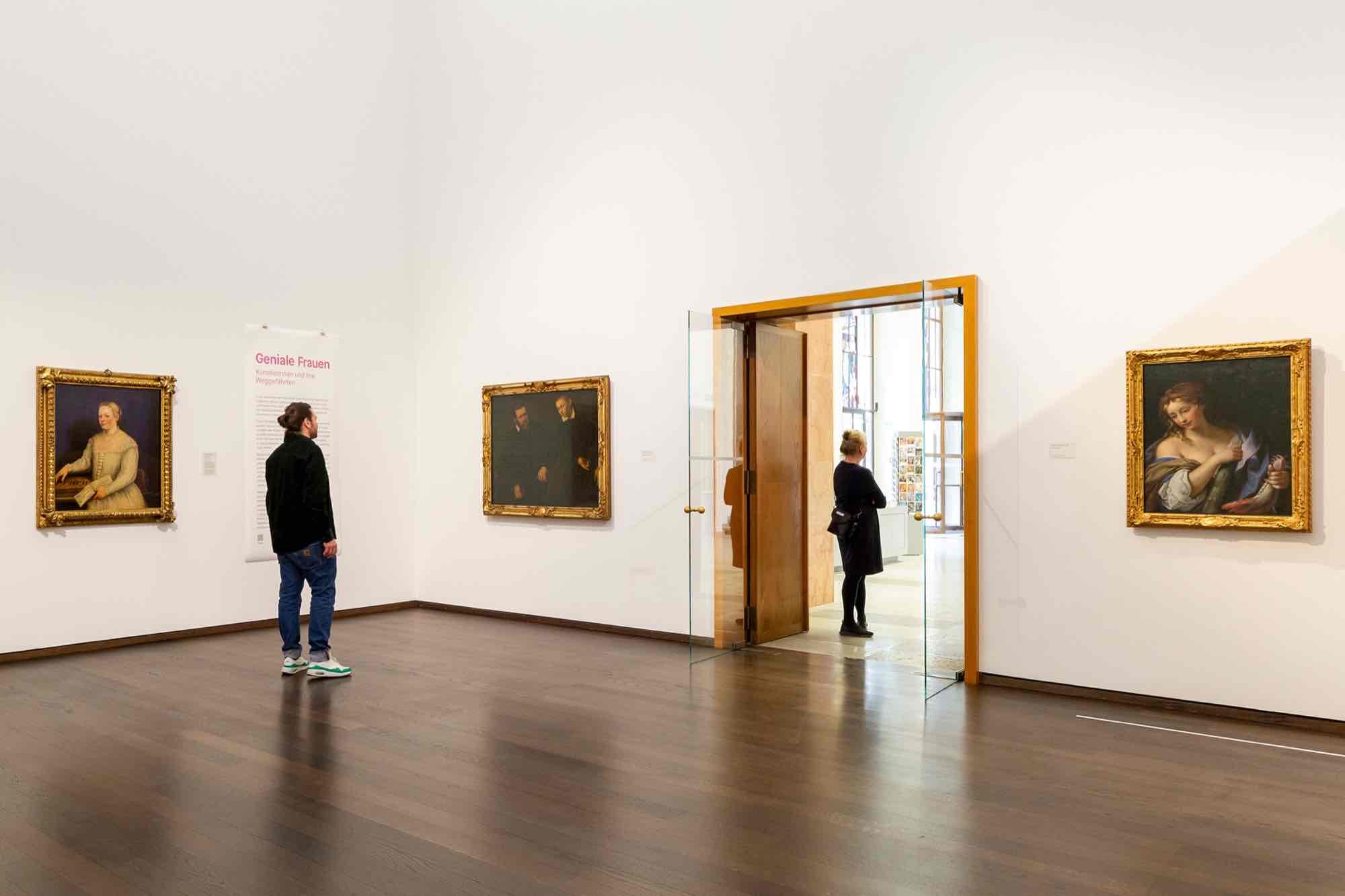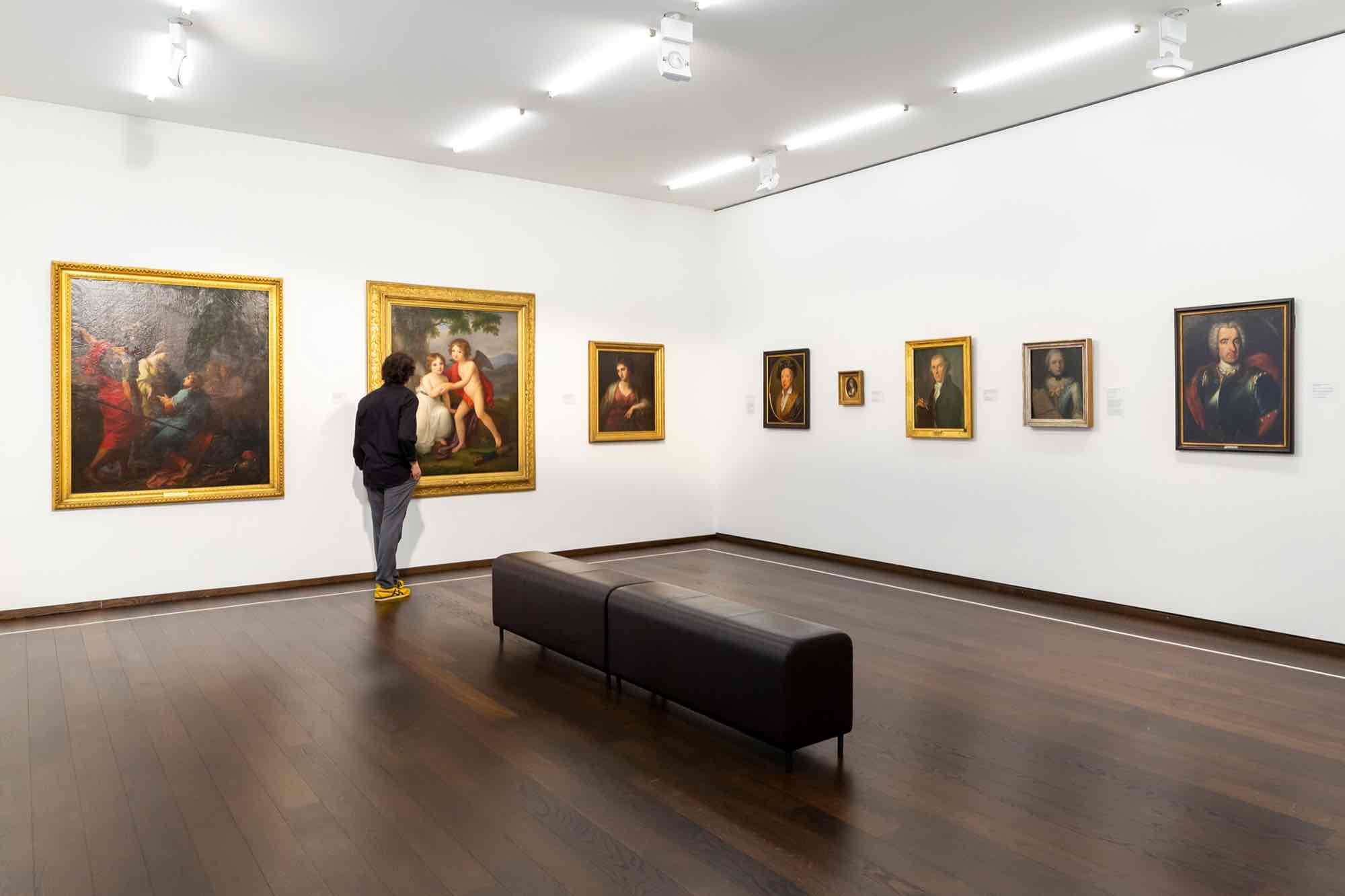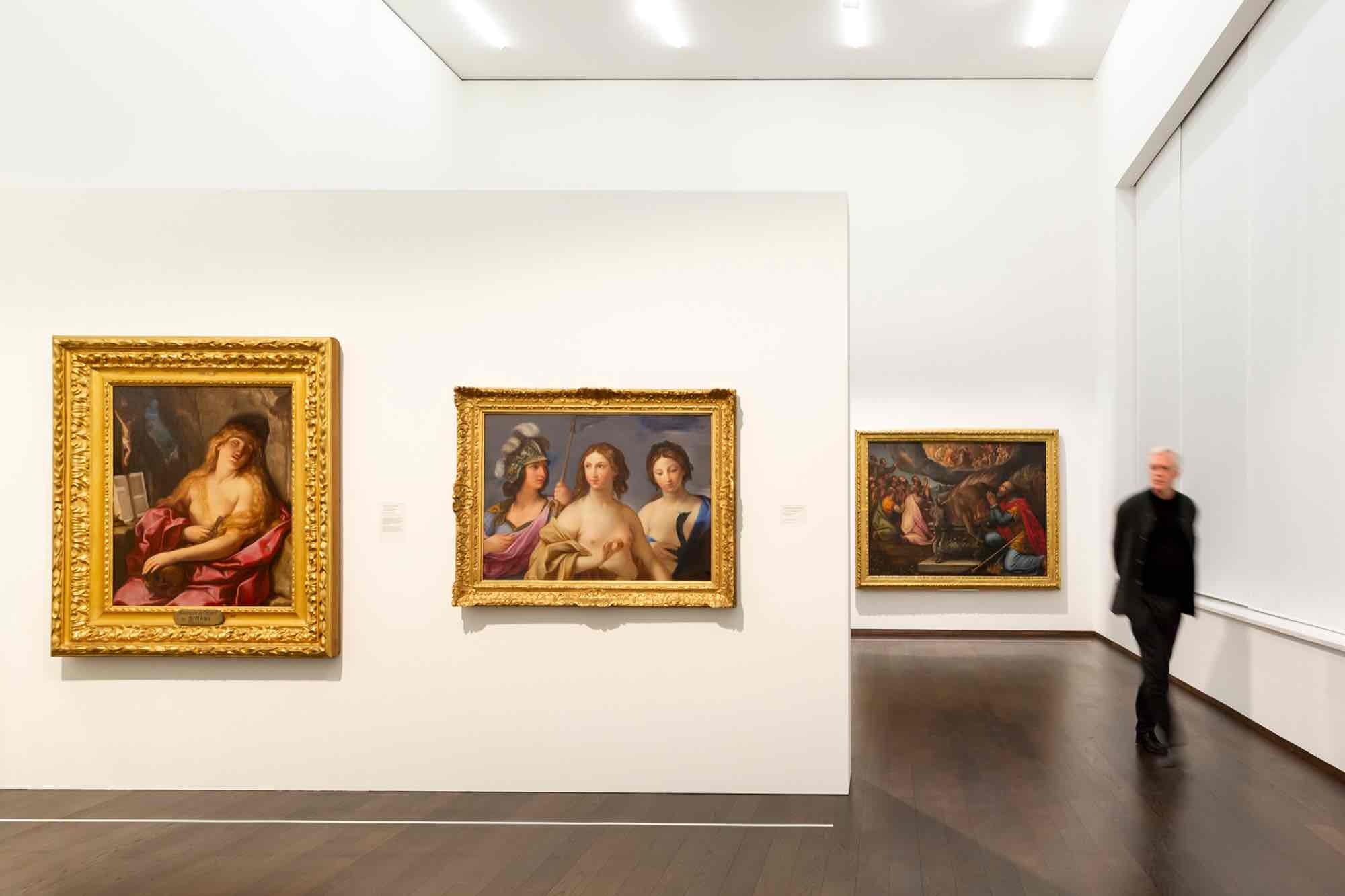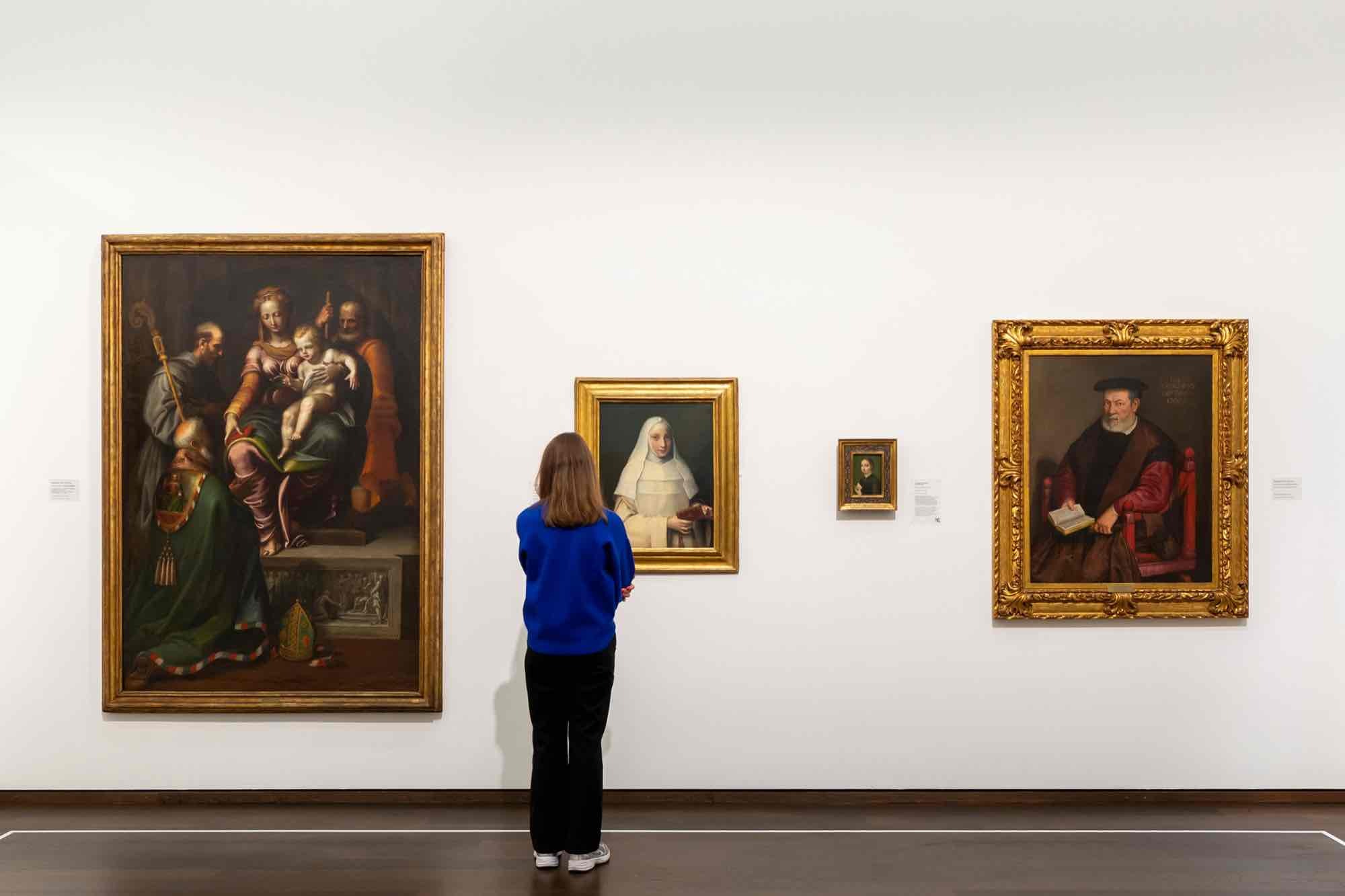Ingenious Women
Women Artists and their Companions
02 Mar - 30 Jun 2024
Curators: Bodo Brinkmann, Katrin Dyballa (Bucerius Kunst Forum), Ariane Mensger
The exhibition Ingenious Women presents around one hundred works by women artists who thrived in the sixteenth through eighteenth centuries as well as their male companions to shed light on the history of early modern art from a fresh angle. It brings together portraits, history paintings, still lifes, drawings, and fine art prints of the Renaissance, Baroque, and Neoclassical periods.
There were far more women painters, teachers, publishers, and graphic artists in both northern and southern Europe between 1500 and 1800 than one might think. Several of them in fact achieved extraordinary success. Yet even if forging a career as an artist was not altogether impossible, women who aspired to do so defied societal expectations and depended on favorable circumstances.
The exhibition Ingenious Women is the first to retrace the careers of individual women artists through pointed contrasts with works by their fathers, brothers, husbands, and competitors and embeds them in the context of the early modern centuries. The focused comparisons make for fascinating studies, revealing creative and thematic parallels as well as divergences. The presentation also sheds light on the women’s social and family backgrounds. And it offers visitors an opportunity to discover works not only by fairly well-known women painters, but also by some of their colleagues who, despite the often high quality of their output, are largely forgotten today.
Daughters, wives, and court painters
Women were barred from joining guilds or enrolling at art academies for centuries. That is why the great majority of women artists came from artistic families that provided them with professional training. Katharina van Hemessen (1528–after 1565), who painted the earliest known self-portrait of a woman artist at work—it is now in the Kunstmuseum Basel’s collection—likely learned to paint in the workshop of her father Jan Sanders van Hemessen (ca. 1500–ca. 1556). In the case of Marietta Robusti aka La Tintoretta (ca. 1554/55–1614), we know that she helped her father Jacopo Rusti aka Tintoretto (1518/19–1594) with his work at a young age before becoming a celebrated painter in her own right.
Others were less lucky and labored in obscurity, assisting their relatives. Their personal artistic styles are often hard to identify, having fused, in accordance with the customary workshop practices of the period, with those evident in their masters’ works. That was the fate of Michaelina Wautier (1604–1689). Others, meanwhile, were married off to artists. Documents show that Rachel Ruysch’s (1664–1750) husband, the painter Juriaen Pool (1666–1745), not only gave her permission to paint—her still lifes in fact outsold his own, and he materially supported her in her work. She was the first woman to be inducted into the painters’ guild in The Hague.
More often than not, however, marriage—as Judith Leyster (1609–1660) found—meant that women had to renounce their own professional aspirations and submit to their husbands’ authority. Some of them went on to support their spouses in the workshop, but for many, children and the family now took up much of their time. This prospect was why other women artists, like Maria van Oosterwijk (1630–1693), chose to remain single.
Considerably rarer yet the more remarkable are the women artists who were born with no personal connection to the artistic professions and still learned to paint. Examples include daughters of noble and bourgeois families as well as tradespeople. Sofonisba Anguissola (1532–1625) trained with the painter Bernardino Campi (1522–1591); her father’s targeted efforts to ‘market’ her work subsequently helped her garner an appointment as painter to the Spanish royal court. Contacts at courts enabled women artists to win fame and honor for themselves and later aided them as they sought admission to academies. Katharina Treu (1743–1811), for instance, became the first woman professor at a German academy thanks to the patronage of Count Palatine Charles Theodor. Angelika Kauffmann (1741–1807) is presumably the best-known woman artist and teacher, counting membership in the Royal Academy in London among her accolades. Yet these women, too, could not have achieved their successes without the support of the men around them
Portraits and flower still lifes are the dominant subjects in the output of women artists of the centuries under consideration. But exceptions do exist: every now and then, an artist even tried her hand at history painting, the highest-ranking genre. There are no “typically feminine” subjects, that is to say; rather, the motifs are a reflection above all of the particular time and place in which an artist lived. Her clients, too, determined which subjects she painted: the Netherlands and Germany saw the rise of a bourgeois clientele for art, whereas the aristocracy remained ascendant in Italy and Spain, where the Church was also still a source of major commissions. And clients’ demands determined the formats as well; one reason why, in parts of northern Europe, the (smaller) genre painting won out over the history painting from the seventeenth century onward, while the latter form continued to flourish in the south. Portraits and flower still lifes, meanwhile, are found in the oeuvres of women artists in the north and south alike.
From Italy to Germany
In the five galleries on the Kunstmuseum Basel | Hauptbau’s ground floor, the nineteen women artists are grouped by geographical origins. The spacious first gallery is dedicated to the Italian painters Sofonisba Anguissola, Lavinia Fontana (1552–1614), Marietta Robusti aka Tintoretta, and Elisabetta Sirani (1638–1665); after a smaller room with still lifes by three artists from Italy and France—Fede Galizia (ca. 1574/78–1630), Louise Moillon (ca. 1610–1696), and Anne Vallayer-Coster (1744–1818)—the third gallery features the Netherlandish painters Katharina van Hemessen, Michaelina Wautier, and Judith Leyster. The fourth room focuses on the northern still life, with works by Rachel Ruysch, Maria van Oosterwijk, Maria Sibylla Merian (1647–1717), and Alida Withoos (1662–1730). The exhibition concludes with the Germans Katharina Treu and Dorothea Therbusch (1721–1782) and the Swiss Anna Waser (1678–1714), Anna Barbara Abesch (1706–1773), and Angelika Kauffmann in the fifth gallery.
A special excursus in the exhibition is devoted to female artists in print business. In the workshops in which copperplates were engraved or etched no less than in painting studios, women typically worked among family members. However, custom had it that prints bore extensive information on the manufacturers, and so the names of the contributing women artists are more often documented. In the graphic art cabinets on the Hauptbau’s first floor, case studies showcase three leading representatives of this type of woman artist: Diana Mantovana (ca. 1547 – 1612), a daughter of the MantuanRoman family of engravers of the same name; Magdalena de Passe (1600–1638), a highly prolific contributor to her father Crispijn de Passe’s enterprise in Cologne and later in Utrecht; and Maria Katharina Prestel (1747–1794), who married her teacher Johann Gottlieb Prestel and together with him went into the then-booming business in reproductive prints.
The exhibition Ingenious Women presents around one hundred works by women artists who thrived in the sixteenth through eighteenth centuries as well as their male companions to shed light on the history of early modern art from a fresh angle. It brings together portraits, history paintings, still lifes, drawings, and fine art prints of the Renaissance, Baroque, and Neoclassical periods.
There were far more women painters, teachers, publishers, and graphic artists in both northern and southern Europe between 1500 and 1800 than one might think. Several of them in fact achieved extraordinary success. Yet even if forging a career as an artist was not altogether impossible, women who aspired to do so defied societal expectations and depended on favorable circumstances.
The exhibition Ingenious Women is the first to retrace the careers of individual women artists through pointed contrasts with works by their fathers, brothers, husbands, and competitors and embeds them in the context of the early modern centuries. The focused comparisons make for fascinating studies, revealing creative and thematic parallels as well as divergences. The presentation also sheds light on the women’s social and family backgrounds. And it offers visitors an opportunity to discover works not only by fairly well-known women painters, but also by some of their colleagues who, despite the often high quality of their output, are largely forgotten today.
Daughters, wives, and court painters
Women were barred from joining guilds or enrolling at art academies for centuries. That is why the great majority of women artists came from artistic families that provided them with professional training. Katharina van Hemessen (1528–after 1565), who painted the earliest known self-portrait of a woman artist at work—it is now in the Kunstmuseum Basel’s collection—likely learned to paint in the workshop of her father Jan Sanders van Hemessen (ca. 1500–ca. 1556). In the case of Marietta Robusti aka La Tintoretta (ca. 1554/55–1614), we know that she helped her father Jacopo Rusti aka Tintoretto (1518/19–1594) with his work at a young age before becoming a celebrated painter in her own right.
Others were less lucky and labored in obscurity, assisting their relatives. Their personal artistic styles are often hard to identify, having fused, in accordance with the customary workshop practices of the period, with those evident in their masters’ works. That was the fate of Michaelina Wautier (1604–1689). Others, meanwhile, were married off to artists. Documents show that Rachel Ruysch’s (1664–1750) husband, the painter Juriaen Pool (1666–1745), not only gave her permission to paint—her still lifes in fact outsold his own, and he materially supported her in her work. She was the first woman to be inducted into the painters’ guild in The Hague.
More often than not, however, marriage—as Judith Leyster (1609–1660) found—meant that women had to renounce their own professional aspirations and submit to their husbands’ authority. Some of them went on to support their spouses in the workshop, but for many, children and the family now took up much of their time. This prospect was why other women artists, like Maria van Oosterwijk (1630–1693), chose to remain single.
Considerably rarer yet the more remarkable are the women artists who were born with no personal connection to the artistic professions and still learned to paint. Examples include daughters of noble and bourgeois families as well as tradespeople. Sofonisba Anguissola (1532–1625) trained with the painter Bernardino Campi (1522–1591); her father’s targeted efforts to ‘market’ her work subsequently helped her garner an appointment as painter to the Spanish royal court. Contacts at courts enabled women artists to win fame and honor for themselves and later aided them as they sought admission to academies. Katharina Treu (1743–1811), for instance, became the first woman professor at a German academy thanks to the patronage of Count Palatine Charles Theodor. Angelika Kauffmann (1741–1807) is presumably the best-known woman artist and teacher, counting membership in the Royal Academy in London among her accolades. Yet these women, too, could not have achieved their successes without the support of the men around them
Portraits and flower still lifes are the dominant subjects in the output of women artists of the centuries under consideration. But exceptions do exist: every now and then, an artist even tried her hand at history painting, the highest-ranking genre. There are no “typically feminine” subjects, that is to say; rather, the motifs are a reflection above all of the particular time and place in which an artist lived. Her clients, too, determined which subjects she painted: the Netherlands and Germany saw the rise of a bourgeois clientele for art, whereas the aristocracy remained ascendant in Italy and Spain, where the Church was also still a source of major commissions. And clients’ demands determined the formats as well; one reason why, in parts of northern Europe, the (smaller) genre painting won out over the history painting from the seventeenth century onward, while the latter form continued to flourish in the south. Portraits and flower still lifes, meanwhile, are found in the oeuvres of women artists in the north and south alike.
From Italy to Germany
In the five galleries on the Kunstmuseum Basel | Hauptbau’s ground floor, the nineteen women artists are grouped by geographical origins. The spacious first gallery is dedicated to the Italian painters Sofonisba Anguissola, Lavinia Fontana (1552–1614), Marietta Robusti aka Tintoretta, and Elisabetta Sirani (1638–1665); after a smaller room with still lifes by three artists from Italy and France—Fede Galizia (ca. 1574/78–1630), Louise Moillon (ca. 1610–1696), and Anne Vallayer-Coster (1744–1818)—the third gallery features the Netherlandish painters Katharina van Hemessen, Michaelina Wautier, and Judith Leyster. The fourth room focuses on the northern still life, with works by Rachel Ruysch, Maria van Oosterwijk, Maria Sibylla Merian (1647–1717), and Alida Withoos (1662–1730). The exhibition concludes with the Germans Katharina Treu and Dorothea Therbusch (1721–1782) and the Swiss Anna Waser (1678–1714), Anna Barbara Abesch (1706–1773), and Angelika Kauffmann in the fifth gallery.
A special excursus in the exhibition is devoted to female artists in print business. In the workshops in which copperplates were engraved or etched no less than in painting studios, women typically worked among family members. However, custom had it that prints bore extensive information on the manufacturers, and so the names of the contributing women artists are more often documented. In the graphic art cabinets on the Hauptbau’s first floor, case studies showcase three leading representatives of this type of woman artist: Diana Mantovana (ca. 1547 – 1612), a daughter of the MantuanRoman family of engravers of the same name; Magdalena de Passe (1600–1638), a highly prolific contributor to her father Crispijn de Passe’s enterprise in Cologne and later in Utrecht; and Maria Katharina Prestel (1747–1794), who married her teacher Johann Gottlieb Prestel and together with him went into the then-booming business in reproductive prints.





